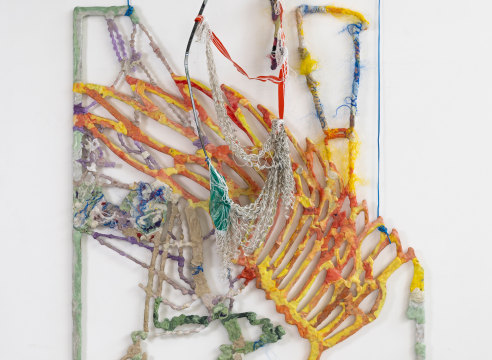

With Julien Creuzet accompanied by Phoebe Collings-James, Christina Kimeze, Manuel Mathieu, Bruno Peinado & Chloé Quenum
Curated by Céline Kopp et Cindy Sissokho
With the support and essential artistic collaboration of Julien Creuzet’s Studio Chadine Amghar, Garance Cabrit, Scarlett Chaumien (coordination), Iris Fabre, Louis Somveille
Thanks to artists collaborators Antoine Camus (designer), Julien Coetto, Émilien Colombier, Oscar Julian Mantilla et Pierre Lecann (motion designers), Ana Pi (chorégraphe), Mo Laudi, Timothée Sarran (compositeurs), Makeda (chanteuse), Estelle Coppolani (bibliographie)
As a prelude to Julien Creuzet's artistic project for the French Pavilion at the 60th edition of the International Biennale of Art — La Biennale Di Venezia (20 April 2024 to 24 November 2024), this exhibition is a moment to retrospectively acknowledge Creuzet's wide artistic practice. This collective landscape proposes a dialogue with five other contemporary voices. Plurality is a creative context that has always accompanied his artistic processes: one that is a nest for nurturing exchanges and articulating new languages.
From the start of his practice, Julien Creuzet has reflected on the metaphor and critical notion of the archipelago, which manifests in the wide range of media composing his work. He borrows from the Caribbean thinker Édouard Glissant (1928-2011) a vision of the world, not understood as a fixed and monolithic ecosystem but a place composed of vital interdependencies. Transnational and spiritual connections, in parallel to his own quotidian experiences, have also shaped his artistic practice following the rhythm of a wave across times and places. This dedicated exhibition to Creuzet, Oh téléphone, oracle noir (...)*, shines a light on the multiplicity of voices and references that the work connects to, thus carving out a shared thinking space.
Artists Phoebe Collings-James, Christina Kimeze, Bruno Peinado, Manuel Mathieu and Chloé Quenum's common ground is relative to the politics of bodies in constant movement, the renewal in states of individual and collective limbo, and the importance of sound. Their relationship to space alternately emerges as contested, reclaimed, or found anew through political forms that their works generously offer.
Beneath the glass ceiling, Creuzet inhabits La Rue with a horizontal landscape: a spatial proposition of selected sculptures and recent video works that witness the organic textural lives of his forms. The Grande Galerie and Auditorium present an unprecedented focus on his video works, with a selection dating from 2015 to today, core to the relational exercise with other mediums and artists. The title of the exhibition is borrowed from his first video work Oh Telephone, oracle noir (...)*, in which Creuzet appears alone, in the dark, giving his phone the power of an obsidian stone. It is within this frame, that the exhibition hosts collective connections and presences, deeply anchored in a shared imaginary. This exhibition is a soft, colorful, lively and poetic invitation; a timely visibility of forgotten memories and existences rearticulating resistance through creation.
Julien Creuzet (b.1986 in the Parisian suburbs) grew up in Martinique and now lives and works in Montreuil (France). Past solo exhibitions include the LUMA Foundation, Arles and Zurich, 2022–23; Camden Arts Centre, London, 2021; CAN Centre d’art Neuchâtel, 2019; Palais De Tokyo, Paris, 2019; and Fondation Ricard, Paris, 2018. Creuzet has also participated in numerous group exhibitions, including the 35th São Paulo Bienal; 12th Liverpool Biennial; Museum of Contemporary Art Chicago; Musée Tinguely, Basel; National Gallery of Prague; Wesleyan University Center for the Arts, Middletown; Manifesta 13 Marseille; Musée d’Art Moderne de Paris; Kampala Biennale); Gwangju Biennale. In 2021, Creuzet was nominated for the Prix Marcel Duchamp, and in 2019 was the recipient of the Camden Arts Centre Prize at Frieze London.
He will represent France at the 60th International Art Exhibition—the Venice Biennale in 2024 with curators Céline Kopp and Cindy Sissokho.